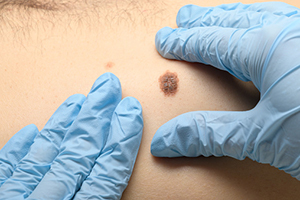As reported in the Journal of Clinical Oncology, El Sharouni et al have developed nomograms to predict local, regional, and distant recurrence in patients with T1 melanomas.

Photo credit: Getty
Study Details
The study used data from a Dutch population-based cohort of 25,930 patients to develop the nomograms. The validation cohort consisted of 2,968 patients from an Australian melanoma treatment center. Multivariable Cox models were generated for local, regional, and distant recurrence–free survival. Discrimination was assessed using Harrell’s C-statistic for each outcome.
Key Findings
Median follow-up was 6.7 years in the Dutch cohort and 12.0 years in the Australian cohort. Local, regional, and distant recurrences were observed in 209 (0.8%), 503 (1.9%), and 203 (0.8%) patients in the Dutch cohort and in 23 (0.8%), 61 (2.1%), and 75 (2.5%) patients in the Australian cohort.
Nomograms developed in the Dutch cohort included:
- Age, primary site, Breslow thickness, melanoma subtype, ulceration, and mitoses for 10-year local recurrence–free survival
- Sex, primary site, Breslow thickness, melanoma subtype, ulceration, mitoses, and sentinel node status for 10-year regional recurrence–free survival
- Sex, primary site, Breslow thickness, ulceration, mitoses, and sentinel node status for 10-year distant recurrence–free survival.
In the Dutch development cohort, C-statistics were 0.79 (95% confidence interval [CI] = 0.75–0.82) for local, 0.77 (95% CI = 0.75–0.78) for regional, and 0.80 (95% CI = 0.77–0.83) for distant recurrence–free survival.
In the Australian validation cohort, C-statistics were 0.80 (95% CI = 0.69–0.90) for local, 0.76 (95% CI = 0.70–0.82) for regional, and 0.74 (95% CI = 0.69–0.80) for distant recurrence–free survival.
Using the nomograms, C-statistics were increased by 9% to 12% for the development cohort and by 11% to 15% for the validation cohort vs the American Joint Committee on Cancer (AJCC) staging system using T stage and sentinel node status to predict survival in T1 melanomas. Use of the AJCC staging system yielded C-statistics of 0.67, 0.68, and 0.70, for local, regional, and distant recurrence–free survival in the development cohort, and 0.65, 0.66, and 0.65, respectively, in the validation cohort.
The investigators concluded, “Most patients with thin melanomas have an excellent prognosis, but some develop recurrence. The presented nomograms can accurately identify a subgroup at high risk. An online calculator is available at melanomarisk.org.au.”
John F. Thompson, MD, of Melanoma Institute Australia, North Sydney, is the corresponding author for the Journal of Clinical Oncology article.
Disclosure: The study was supported by the European Association of Dermatology and Venereology, Australian National Health and Medical Research Council, Cancer Institute New South Wales, and Melanoma Institute Australia. For full disclosures of the study authors, visit ascopubs.org.

